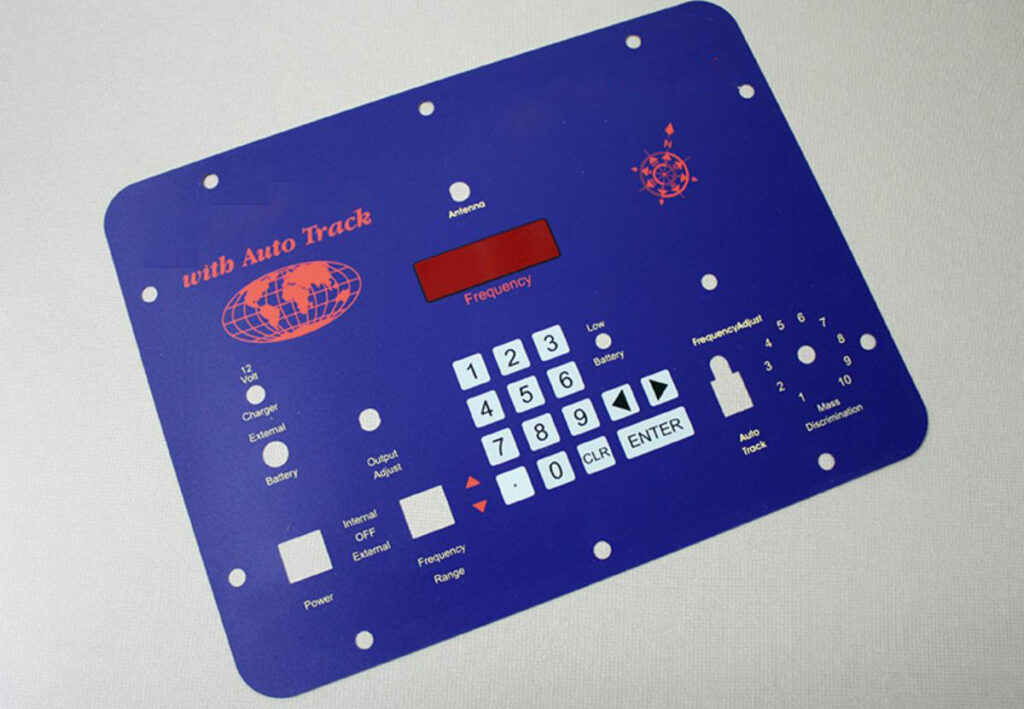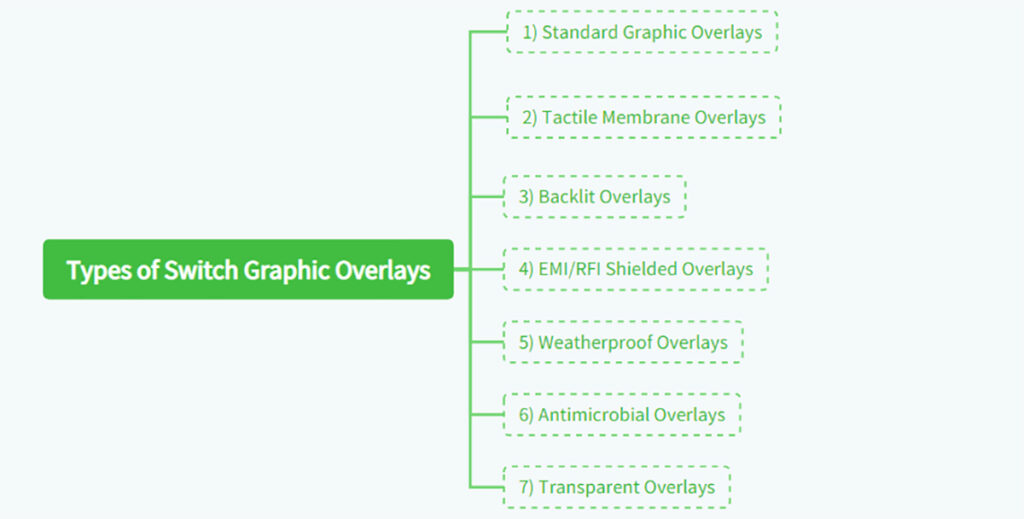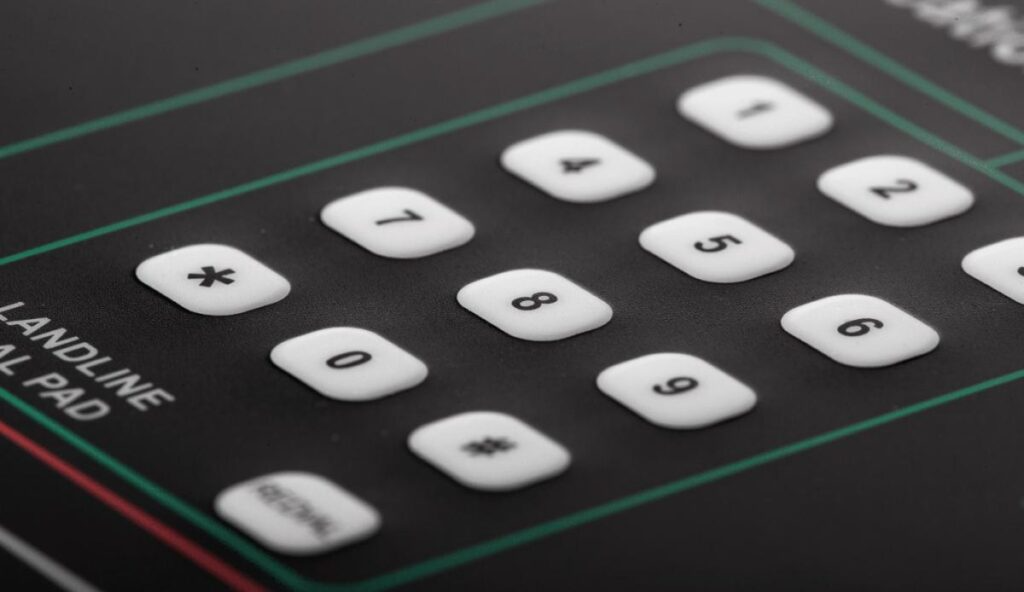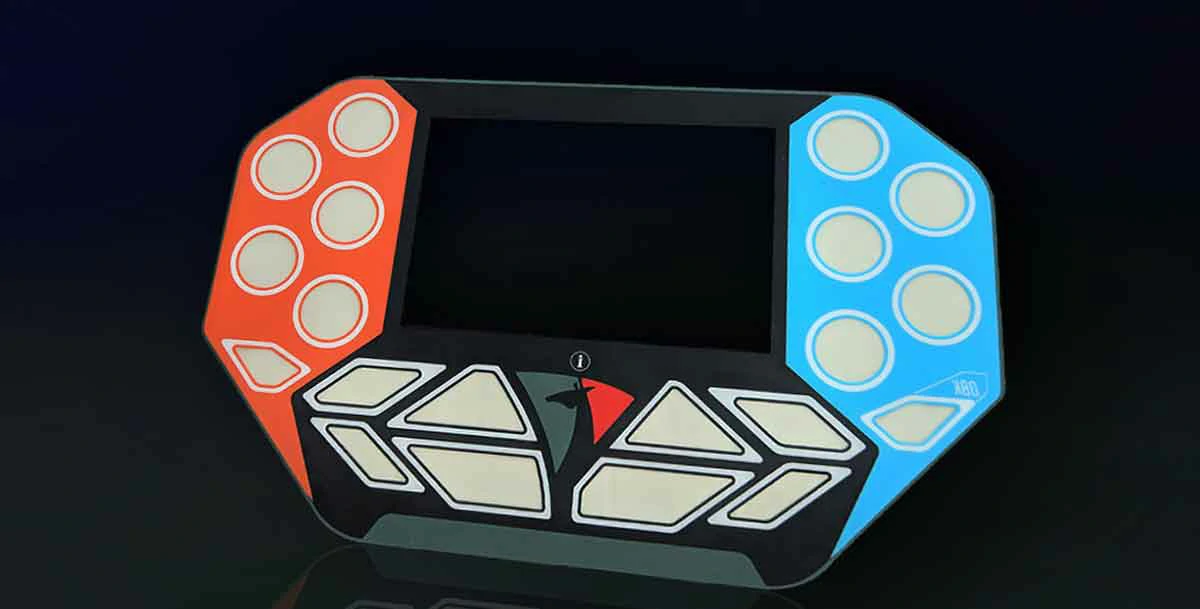In the densely interconnected world of contemporary electronics, graphic overlays are unsung champions, providing critical functionality and esthetics to mass devices. Graphic overlays for switch applications specifically are a vital component of user interface setup. Not only a visual interface, they are a functional barrier as well, protecting and prolonging the life of switches and keypads. This comprehensive FAQ guide delves into the in’s and out’s of switch graphic overlays, providing informative material to guide you toward better decision-making and maximize their utilization.
1. What is a Switch Graphic Overlay?
A switch graphic overlay is a well-designed interface layer that overlays switches and keypads, both providing visual and functional benefits. Composed of durable materials such as polycarbonate or polyester, the overlays are also printed with graphics, symbols, and textual information that guide the user and protect the underlying switch mechanisms from exposure to nature.
Visual appearance is typically achieved using advanced printing techniques in order to facilitate the use of colorful, high-quality graphics or dainty, crisp patterns, depending on need. The functionality part usually comes with haptic feedback, making the user interface feel natural and smooth.

2. Types of Switch Graphic Overlays
Switch graphic overlays exist in many forms, each tailored to various functional and environmental uses. Overlay choice is based on the application, environment the device would be used in, and user experience desired. The most common types of switch graphic overlays include:
1) Standard Graphic Overlays
Standard graphic overlays are the simplest kind, intended mostly for information and aesthetic purposes. They consist of printed letters, symbols, and images that assist the user in the use of the device. Though they offer some protection to the switches underneath, their main purpose is to add beauty to the device and offer easy instructions to the user.
2) Tactile Membrane Overlays
Tactile membranes overlays are applied to provide tactile feedback when a button or switch is pressed. This can be achieved by providing raised or embossed areas in the overlay so that the user gets some physical sensation when pressed. Tactile feedback is particularly necessary in situations where the users have to be able to discern whether a button was pressed or not without visual inspection. The overlays are employed widely in medical equipment, industrial control panel interfaces, and heavy machine interfaces.
3) Backlit Overlays
Backlit overlays are designed exclusively to be lit from the back, normally by LEDs. This allows more readability of the overlay in dim or dark conditions and ensures that it is easy for the user to interact with the device. Backlit overlays have applications in numerous car dashboard uses, flight control panels, and other locations where visibility is a concern, especially when used during nighttime.
4) EMI/RFI Shielded Overlays
EMI and RFI interfere with sensitive electronic devices and hinder their proper functionality. The EMI/RFI shielded overlays eliminate these kinds of interference by the addition of conductive materials into the overlay. Shielding from the outside electromagnetic fields protects the device, so dependable performance may be achieved even in high interference environments, like medical devices, military, and high-frequency communication equipment.
5) Weatherproof Overlays
Weather-resistant overlays are built to withstand unfavourable climatic conditions such as moisture, dust, weather extremes, and UV. Weather-resistant overlays are made with resistant materials that stand the weather as well as to be normally sealed to exclude water. Weather-resistant overlays find major applications outdoors where equipment or boxes need to meet durability as well as resistance from the weather such as kiosks, meteorological stations, and nautical equipment.
6) Antimicrobial Overlays
Where hygiene must be of the highest order, i.e., hospitals and laboratories, antimicrobial overlays are utilized to protect against bacteria, mold, and other harmful microorganisms developing on the overlay surface. Antimicrobial finishes that prevent the growth of pathogens cover the overlays, rendering them ideal to be used with medical equipment, food preparation equipment, and other areas where hygiene is central.
7) Transparent Overlays
Transparent overlays are used where the underlying display or components should be visible. Transparent overlays protect the switches or displays without blocking the view. Transparent overlays are typically applied to touchscreens, control panels, and other devices where aesthetics are important.

3. How to Choose the Right Material for Your Environment and Design?
The selection of the appropriate material for a switch graphic overlay is one of the most important decisions in the design process. The material will determine how the appearance, feel, and functionality of the overlay stay over the life of the product. The choice is to pick the right one by balancing functionality, robustness, cost, and look so that the overlay is suitable for both the device environment and the user experience requirement.
1) Understanding Material Behavior
Different overlay materials have different reaction to chemicals, heat, pressure, and light. Having knowledge about the basic properties that affect actual performance is useful before coming to a conclusion.
- Transparency and Optical Clarity: Polymeric overlays employed for display or indicator windows should possess high light transmission characteristics such as polycarbonate or polyester to yield clear clarity.
- Surface Hardness and Scratch Resistance: Hard-coated wear-resistant films with abrasion resistance can resist wear and are scratch-free even for long term use.
- Thermal and Chemical Resistance: Hospital or commercial use can subject overlays to heat, cleansers, or solvents. Polyester is preferable to polycarbonate in these applications.
- UV Stability and Aging Resistance: Coatings or films for outdoor exposure applications require UV resistance to prevent yellowing and brittleness.
- Formability and Tactile Response: If your overlay has embossed buttons or rounded topographies, it is simpler to deform and flex polycarbonate without cracking.
Comparing Common Materials
| Material | Key Strengths | Limitations | Ideal Use Cases |
| Polycarbonate (PC) | Excellent clarity, smooth print surface, strong impact resistance, easy to emboss. | Limited chemical and UV resistance without protective coatings. | Indoor control panels, medical devices, home appliances. |
| Polyester (PET) | Outstanding chemical and heat resistance, excellent durability, consistent dimensions. | Stiffer and less formable, limited deep embossing. | Industrial equipment, outdoor controls, automotive dashboards. |
| PVC (Polyvinyl Chloride) | Cost-effective, flexible, easy to print in small batches. | Prone to aging, poor UV performance, shorter lifespan. | Low-cost or short-term products, promotional electronics. |
| Composite Films (PC + PET) | Combines PC’s transparency with PET’s strength and resistance, suitable for complex, multi-layer designs. | Higher price and stricter bonding requirements. | High-end devices, illuminated overlays, multifunctional interfaces. |
2) Choosing the Right Material for Different Environments
The best material will depend in large part on where and how the overlay will be installed. Keep the following in mind:
- Equipment Indoors: Polycarbonate offers excellent clarity, color rendition, and embossing possibilities for general applications.
- Outdoor Use: Apply PET or coated PC films to improve UV and weather resistance.
- Chemical or Medical Use: PET is more resistant to chemicals from cleaning products, alcohol, and sterilizing chemicals than PC.
- High-Temperature Environment: PET does not warp or delaminate at high operating temperatures and is stable.
- High-Impact or Low-Temperature Areas: Polycarbonate is tougher and more impact-resistant under mechanical stress or low temperatures.
3) Practical Steps to Select the Best Material
Determine the environment initially
- Enumerate the anticipated conditions such as range of temperature, humidity, UV exposure, and chemical contact.
- Request small test samples to test print adhesion, surface hardness, and clarity at all times.
- Negotiate directly with the supplier material availability, tooling capacity, and coating implications. Their history can help you design for cost-effectiveness and long-term life.
Optimize performance vs. cost
- While higher-end materials perform better, they are not necessarily needed. A mid-grade PC or PET with the right protection layer can provide excellent durability without overspending.
- Material selection is more than a technical choice; it’s a strategic one. It decides how people will use the product, how long it will last, and how easily it can be repaired.
- The materials protect the switches from dust, water, chemicals, and other liquids, prolonging the life of the device greatly.
4. Advantages of Switch Graphic Overlays
Switch graphic overlays offer numerous advantages that make them indispensable in modern design and engineering:
1) Improved Strength
Graphic switch overlays are made with strong materials such as polycarbonate and polyester that are resistant to wear and tear, and environmental stress. The materials protect the switches from dust, water, chemicals, and other liquids, which prolongs the life of the device greatly. This ruggedness is important in outdoor and industrial applications, where the devices experience extreme conditions.
2) Improved User Experience
The visual simplicity created by way of high-definition images, coupled with the haptic feedback of touch, enhances usability. The ease of knowing what each button or switch does comes before the users, while haptic feedback will assure them whether they have pressed a button or not. The usability is enhanced and augmented in its utilization of intuitiveness, which sees to it that user error is kept to a minimum.
3) Aesthetic Flexibility
Switch graphic overlays are very flexible, and manufacturers can create overlays to their own brand standards and design specifications. If the appearance is to have bold, high-contrast graphics or a highly minimalist, low-key look, overlays can be designed to meet the precise demands of the product. This type of flexibility makes them very ideal for consumer electronics, where look is one of the largest sales attractions.
4) Cost-Effective Customization
Compared to more complex mechanical assemblies, switch graphic overlays are an affordable method of device interface updating and customization. Graphic or layout changes can be comparatively simple at design time, allowing manufacturers to create differentiated, branded interfaces without costly tooling or mechanical redesign expenditures.
5) Reduced Assembly and Maintenance
Switch graphic overlays typically are designed such that they fit readily into the overall look of the device and facilitate both assembly and later maintenance. Overlays are typically adhesive-backed and can be attached onto the device surface. If an overlay needs to be replaced, it is easy to replace without having to take the whole device off.
6) Chemical Resistance
Most switch graphic overlays are made to be chemically resistant due to chemical exposure so that they can be utilized within an industrial setting where heavy-duty cleaners or strong cleaners will be used. Their chemical resistance implies that the overlay will remain functional and appear good even under harsh conditions.
7) EMI/RFI Resistance
For the applications that have high electromagnetic or radio-frequency interference, EMI/RFI shielded overlays provide an extra layer of safeguard. Overlays allow the devices to operate dependably for mission-critical applications such as medical devices and military equipment by preventing interference from entering and affecting the device functionality.

5. Disadvantages of Switch Graphic Overlays
While beneficial, switch graphic overlays also have some limitations worth considering:
1) Limited Repairability
A second drawback to switch graphic overlays is that they are not easily repaired when damaged. When the overlay becomes wet, scratched, worn, or delaminated, most typically it must be replaced in its entirety. As opposed to mechanical components, which are typically adjustable or repairable, a damaged overlay is not reparable short of replacing the entire interface layer.
2) Initial Design Complexity
It is often a challenging endeavor to create an overlay for a proprietary switch graphic, particularly for products that contain specialized features such as tactile, backlighting, or shielded EMI/RFI. The procedure includes determining the correct material, print process, and adhesive system and having the overlay interface correctly with the base switches and electronics. The level of complexity may stretch the length and cost of the design process.
3) Wear and Tear Potential
Though switch graphic overlays are designed to be durable, they will still deteriorate over time under heavy usage environments. Multiplicity of button presses could result in the fading of graphics or degradation of tactile feedback elements. In some cases, overlay replacement to restore its visual and functional characteristics will be required.
4) Environmental Limits
Though most switch graphic overlays are designed to be weather or environmental resistant, even harsh conditions will affect the performance and longevity of the overlays. For example, UV light exposure over a prolonged duration will cause the graphics to peel off, while exposure to high temperatures will lead to degradation of the material. In very harsh environments, additional protective factors might be necessary to give the lifespan to the overlay. In very harsh environments, protective elements may be required alongside to ensure the overlay’s lifespan.

6. Maintenance of Switch Graphic Overlays
Switch graphic overlays maintenance is important for guaranteeing they remain functional and last long. Below are tips on how to maintain them:
1) Routine Cleaning
In its effort to preserve the overlay in its best state to look and act at its best, clean it periodically with soap water and a soft wet cloth. Avoid using strong cleaners, solvents, and chemicals because they will remove the surface from the overlay or dull the gloss on the color of the graphics. Clean oleophobic-coated overlays by removing fingerprints and smudges with a microfiber cloth that will not disrupt the coating.
2) Regular Check-Ups
Monitor the overlay from time to time for any indication of degradation such as graphic wear, delamination, or loss of touch response. Identify any fault in its early stages and fix it so that further damage is not done. At times, the overlay will have to be replaced in order to restore the device’s functionality and aesthetic appeal.
3) Environmental Protection
Offer that indoor overlays don’t encounter harsh outdoor weather conditions unless otherwise instructed by the manufacturer. In applying outdoors, use overlays that can withstand environmental factors such as moisture, UV, and temperature extremes. In very harsh environments, protective covers or enclosures may be best used to cover the overlay for protection.
4) Proper Handling
Handle switch graphic overlay switches with care, particularly when actuating the buttons or switches. Handle with care to avoid excessive force, which can damage the tactile components or delaminate the overlay. In high-use applications, employ overlays with reinforced tactile feedback components for long-term integrity.
7. Switch Graphic Overlay Troubleshooting
In the case of switch graphic overlays with problems, troubleshooting will determine the cause and implement effective solutions. The following are the common problems and their potential solutions:
1) Peeling or Fading of Graphics
Peeling or fading of graphics may occur as a result of prolonged exposure to UV radiation or the application of high-strength cleaning solutions. For fade protection, overlays made of UV-resistant materials must be applied, especially where exterior use is anticipated. Peeling may be addressed with overlays that have better adhesives or protective coatings for delamination protection.
2) Loss of Tactile Feedback
If the touch response of the overlay is no longer responding or no longer functions, perhaps the issue is with the switch mechanism under the overlay and not with the overlay itself. Inspect the switches to ensure that they are functioning properly. If the tactile aspect of the overlay has worn out, then an overlay replacement may be in order to restore the tactile response.
3) Interference Issues
In places where electromagnetic or radio-frequency interference is extreme, EMI/RFI shielded overlays must be used so that breaks in the operation of the device are prevented. If interference is an issue, make sure the overlay is adequately shielded and conductive components are not compromised. In some cases, additional shielding is required in order to ensure dependable operation.
4) Moisture Ingress
Water can interfere with the operation of the overlay and the base switches. If water is leaking through the overlay, check that the seals and gaskets around the overlay are not ruptured. Waterproof seals and gaskets can be fitted to ensure that the device is not water-logged and destroyed. If the overlay is not weatherproof, replace it with a weatherproof type.

8. Applications of Switch Graphic Overlays
Switch graphic overlays find applications across a diverse range of industries and devices:
1) Consumer Electronics
Switch graphics are most appropriately used in consumer electronics like game controllers, remote controls, home appliances, and personal devices. They provide a user-friendly interface without wearing out the underlying switches. For consumer electronics, the look and feel of the overlay is often the main sales factor, and companies use high-resolution graphics and user-definable design to give the product a pleasing appearance.
2) Medical Devices
In the health sector, switch graphic overlays form the core of usability and reliability of diagnostic, patient monitoring, and laboratory equipment. Medical overlays must be hygienic to a high standard and durable, and they often have antimicrobial coatings that stop the growth of pathogens.The graphics themselves must be knife-sharp and offer very good tactile response so medical professionals can operate the devices quickly and precisely.
3) Industrial Controls
Graphic overlay switches are commonly used in industrial control panels, machinery interfaces, and safety systems. In these applications, industrial overlay durability is important because the overlays will have to resist chemicals, dust, moisture, and extreme temperatures. Industrial overlays are often mounted with tactile feedback elements to give the operators feedback about button activations, even in cases of glove operation or challenging operating conditions.
4) Automotive
In automobiles, switch graphic overlays are employed on control panels, infotainment, and dashboards. Overlays provide riders and drivers with a high-tech, contemporary look along with shielding the electronics underneath from scratching. Backlit overlays are especially prevalent in vehicle uses since they improve illumination under low light.
5) Aerospace
Switch graphic overlays are used in the aerospace field, where aircraft control panel, navigation, and communication interfaces all feature switch graphic overlays. Reliability and ruggedness are of utmost importance in such applications because overlays must function flawlessly under rugged operating conditions. EMI/RFI shielding is used most commonly in aerospace overlays so that interference will not disrupt sensitive electronics functioning.
6) Telecommunications
Switch graphic overlays are implemented in different telecommunication control interfaces of equipment to provide operational efficiency and longevity. Overlays are typically equipped with backlight and tactile feedback for improved usability, especially for applications involving rapid and precise input.

9. Switch Graphic Overlay Cost Structure and Optimization Strategies
One of the most critical aspects of successful product development is cost management. Having a sense of how much a switch graphic overlay costs allows designers and purchasing teams to make informed decisions. By looking at each component and seeing how design decisions influence manufacturing, you can achieve the right balance among performance, quality, and cost.
1) Breakdown of Overlay Cost Components
Total cost of a switch graphic overlay can typically be divided into several main categories:
1. Material Costs
Most of the total cost comes from the adhesives, base film, and coatings. Polycarbonate and polyester are used most often, and special finishes such as anti-glare or UV protection can increase the product cost. The proper choice of thickness and coating combination controls both cost and performance.
2. Printing and Finishing Costs
Each color, print layer, and curing step adds to manufacturing time and material consumed. Complex patterns or multi-layer backlight designs require more precise printing setups and quality checks, adding to the overall cost.
3. Tooling and Cutting Costs
Special dies, embossing equipment, or cutting dies are often necessary for custom shapes or touch buttons. Large-volume projects can amortize these costs over hundreds of pieces, while small runs will have a higher unit cost due to setup and tool preparation.
4. Labor and Machine Operation
Trained technicians need to regulate printing alignment, layer lamination, embossing, and quality control. Machine calibration, maintenance, and down time also contribute to indirect labor expense.
5. Quality Control and Rework
Inspection is key to maintaining reliability. Reprints or rework generates waste and expense when overlays fail tests such as color uniformity, adhesion, or cut accuracy. A stable process minimizes these expenses.
6. Packaging and Shipping
Proper packaging protects overlays in transit, and shipping cost varies by location, quantity, and transportation method. International orders may also incur customs duties or customs clearance fees.
2) How Design Decisions Affect Cost?
Each design factor has an effect on cost. Foreknowledge prevents unnecessary cost in production. Multi-color and advanced graphics require additional print passes and setup time. Special shapes or tight tolerances increase cutting time and raise the scrap rate. Designing with slightly more forgiving edges can lower reject percentages.
Embossed or backlit features add tooling and assembly complexity. These elements should be reserved for areas that truly benefit from enhanced functionality. Material thickness and coating selection influence not only durability but also complexity of processing. The selection of minimum thickness that will supply necessary strength is typically the most inexpensive solution.
Batch size and order frequency directly affect unit price. Repeated small orders placed consecutively create greater per-run setup expense, while pre-arranged bulk orders reduce per-unit cost.
3) Practical Tips for Driving Down Unit Cost
Pre-plan with your producer. They will be able to suggest alternative materials or coatings that offer the same performance but at a reduced cost.
Standardize designs whenever possible. Using consistent dimensions and cut patterns allows tooling to be reused across models. Optimize color layers. Grouping similar shades or using digital print for gradient will be saving ink and time.
Test prototypes thoroughly. Identification of design or fit issues at the sample level saves money later in rework. Design for manufacturable production. Making larger quantities without needing to adapt production sets the stage for quick, effective manufacturing.
Track and analyze defects. Identification of repeat issues such as misalignment in prints or failure in adhesives can increase yield and reduce waste.
Cost savings is not just lowering the price. It is finding the best way to produce lasting, consistent, and attractive overlays. When manufacturing, engineering, and design teams work together upfront, they can reduce waste, control costs, and deliver a finished product that meets technical and aesthetic goals.
10. How to Collaborate and Communicate with Switch Graphic Overlay Manufacturers?
Tight coordination with a good manufacturer is one of the most effective ways of ensuring the success of your switch graphic overlay job. Upfront design alignment, good documentation, and open communication prevent production errors and incur cost savings. This part outlines how to collaborate effectively with your manufacturing partner, from design to long-term production.
1. Design Review and Technical Handover
A successful project begins with a careful and accurate design package. Before production can begin, share detailed drawings, 3D files, color references, and material specifications with the factory. Provide a written description of functional zones, window transparency, areas of embossing, and adhesive location.
At design review, make the manufacturer verify each detail for manufacturability. Frequently they can suggest material substitutions, tolerance changes, or surface finishes that improve performance or minimize cost. Make sure that final design documents are clear in showing dimensions, printing layers, and cutting profiles so there is no misunderstanding when producing it.
2. Common Questions Checklist for Suppliers
In discussing with manufacturers, it is helpful to create a list of key questions that establish expectations and technical requirements.
- What materials and adhesives do I have to work with for my use?
- Can you provide printed samples or material swatches for approval?
- What are your trimming tolerances, embossing, and color matching?
- How do you handle print registration and accuracy of alignment?
- Do you offer surface treatments such as hard coat, matte, or anti-glare?
- What is the typical lead time for mass production and prototype?
Are test data or inspection reports included in each shipment? - How do you handle reorders or revisions involving design changes?
Having these questions in hand allows both sides to have a clear idea of the project scope before production.
3. Review of Prototypes and Feedback Loops
After initial production, the prototype has to be tested. Work through the samples with your employees and check all the areas such as color consistency, texture, adhesive force, and correctness of size. Record your remarks strictly and present this in writing to the manufacturer.
Building a feedback loop helps both sides refine the process. Even small changes, such as adjusting embossing pressure or changing types of adhesives, can greatly enhance finished quality. Continuing communication after each prototype build maintains the project and avoids possible rework in the future.
4. Long-Term Production Support and Reordering
Once the product is into stable production, having proper cooperation with the factory assures easy re-orders and consistent quality. Ask the factory to keep molds, dies, and electronic art safe for reuse. It is also good to have all production records, materials, and color references on record for traceability.
Monitor product performance on a recurring basis and gather customer feedback. Where new needs or environmental conditions are met, meet them well in advance with the manufacturer and adjust materials or surface treatments as needed. Strong long-term relationships allow for more communication, faster response, and continuous improvement with every production cycle.
Good communication with your manufacturer isn’t always merely about ordering. It is about building a relationship where both sides share technical understanding and trust. By keeping communication open and proactive, you ensure that your switch graphic overlays remain consistent in quality and performance foComposed of robust materials such as polycarbonate or polyester, the overlays are also printed with graphics, symbols, and textual information that inform the user and protect the underlying switch mechanisms from environmental exposure.r years to come.

11. Conclusion
Switch graphic overlays are invaluable in present electronic device interfaces, offering functionality and looks. Their use spans several industries, everything from consumer electronics to industrial control systems, offering user-friendliness, ruggedness, and protective function.
Understanding the type, advantages, drawbacks, servicing, fault tracing, and switch graphic overlay applications optimizes effectiveness and life. Armed with this master guidebook, you now have the sufficient knowledge with the right information to make more informed decisions and locate the perfect overlay for your purposes, maximizing device performance and user satisfaction.





Leave A Comment